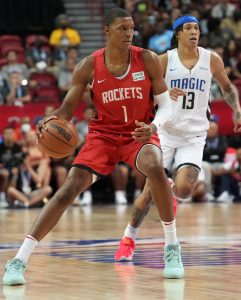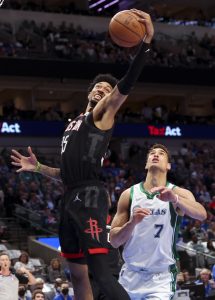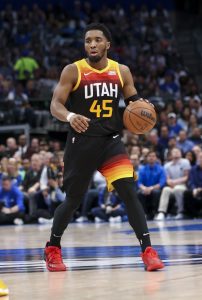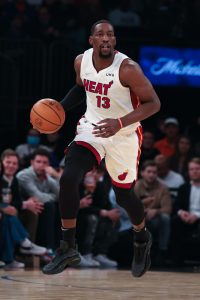This is the first in our series breaking down the major trades of the 2022 offseason. As opposed to giving out grades, this series will explore why the teams were motivated to make the moves. We’re starting with a pre-draft deal between the Mavericks and Rockets…
Most of the immediate reaction to the Rockets sending Christian Wood to the Mavericks in exchange for the 26th pick, Boban Marjanovic, Sterling Brown, Trey Burke and Marquese Chriss was surprise at Wood’s relatively low value, resulting a general sense that the Mavericks got a steal.
So why did the Rockets move Wood for a late first-rounder (the Rockets later flipped the pick for the 29th selection – used on TyTy Washington — and a couple of second-rounders from the Wolves) and four expiring contracts? After all, the talented big man averaged 19.1 points, 9.9 rebounds, 2.1 assists and 1.0 block in 109 games (31.4 minutes) for Houston the past two seasons, posting a shooting line of .507/.384/.626.
 The first part of the answer is easy: After finishing with the worst record in the league for the second straight season, Houston landed the third overall pick in the draft. The Rockets knew that one of Paolo Banchero, Chet Holmgren or Jabari Smith (whom they ultimately selected) would be available at that spot, so they needed to move Wood to clear a minutes logjam in the frontcourt for the incoming rookie and second-year big man Alperen Sengun.
The first part of the answer is easy: After finishing with the worst record in the league for the second straight season, Houston landed the third overall pick in the draft. The Rockets knew that one of Paolo Banchero, Chet Holmgren or Jabari Smith (whom they ultimately selected) would be available at that spot, so they needed to move Wood to clear a minutes logjam in the frontcourt for the incoming rookie and second-year big man Alperen Sengun.
Wood is too good to not play, and having him come off the bench in place of rookie and a second-year player doesn’t make sense for either side – Wood would be unhappy, and you don’t get optimal value by not showcasing a player you’re looking to deal. Wood is also on expiring contract of his own ($14.3MM), turns 27 before the season, and wasn’t in the team’s long-term plans, so all of those things hurt Houston’s negotiating leverage.
It’s also fair to question, to some extent, how much impact Wood actually had on winning in his tenure with the Rockets, considering the team finished with the worst record in the league two years in a row. Obviously, not all of that is on him, yet last season the team had a better net rating when he was off the court (-8.4) than on it (-9.6).
Rockets GM Rafael Stone is smart. All NBA front offices are led by intelligent people. The rest of the league knew that Houston needed to clear minutes in the frontcourt, and considering Wood has outperformed his three-year, $41MM deal, whichever team acquired him also knew it would have to pay him handsomely to keep him around – Wood will be eligible to sign a contract extension worth up to $77MM over four years at the end of December, as ESPN’s Bobby Marks reported at the time of the trade.
Thus, his market value turned out to be the 26th pick and four expiring contracts that range between $2.2MM and $3.5MM. The expiring deals were key for the Rockets, because they project to have a ton of cap space in 2023, and Houston is a large market that could feasibly attract free agents with its young, talented core (the fact that Texas has no state income tax also helps a selling point).
I’m skeptical that any of Marjanovic, Burke, Brown or Chriss have positive value on the trade market, and there’s a good chance most of them won’t be on Houston’s roster before the regular season begins, which is why I refer to them collectively as expiring contracts. The team currently has 18 players on standard deals and that number needs to be cut to 15 by October. If any of those players remain on the roster, it will probably be due to their off-court impact as much as what they can do on the court, because the Rockets are in the midst of a rebuild and won’t be prioritizing minutes for veterans.
Still, clearing frontcourt playing time, not having to worry about paying Wood in the future, and acquiring a young player with the potential to be under team control for up to nine years (four years of rookie scale contract plus up to five more via extension or as a restricted free agent) were all appealing reasons to trade Wood, despite how productive he was for Houston.
The Mavericks’ motivation to make the deal was relatively straightforward. Dallas reached the Western Conference Finals last season and entered the offseason with a clear goal in mind of improving the frontcourt, and Wood instantly becomes the most dynamic pick-and-roll partner Luka Doncic has ever been paired with.
There’s no denying Wood is a talented player. Only nine players averaged at least 17 points and 10 rebounds last season: Nikola Jokic, Joel Embiid, Giannis Antetokounmpo, Domantas Sabonis, Jonas Valanciunas, Nikola Vucevic, Deandre Ayton, Bam Adebayo and Wood.
Out of all those MVP winners and All-Stars, Wood had the highest three-point percentage at 39%. He also shot 67% at the rim, which was in the 79th percentile of all players last season, per DunksAndThrees.com.
 The Mavs struggled mightily with rebounding the ball last season. They finished 24th in the league in rebounding during the regular season and were significantly outrebounded in each postseason series they played: -7.1 rebounds per game vs. Utah, -7.7 vs. Phoenix and -11.4 vs. Golden State. Wood was in the 97th percentile for defensive rebounding percentage (30%) last season, per DunksAndThrees.
The Mavs struggled mightily with rebounding the ball last season. They finished 24th in the league in rebounding during the regular season and were significantly outrebounded in each postseason series they played: -7.1 rebounds per game vs. Utah, -7.7 vs. Phoenix and -11.4 vs. Golden State. Wood was in the 97th percentile for defensive rebounding percentage (30%) last season, per DunksAndThrees.
There are also multiple counterarguments that show the Rockets were a much better team when Wood was on the court than off during his tenure.
Despite the aforementioned net rating differential, Houston was 19-49 when he played last season and 1-13 when he didn’t, and 12-29 when he played in ‘20/21 vs. 5-24 when he didn’t. The Rockets were also substantially better when he was on the court (-4.0) in ’20/21 compared to off it (-10.5).
The four players the Mavs sent to the Rockets had minimal on-court value last season, and none were in the rotation in the playoffs. In addition to clearing four roster spots (five-for-one including the first-rounder), Dallas is essentially betting that Wood will outperform a player entering his rookie season, which is a pretty safe gamble.
The risks for the Mavericks stem from the fact that Wood is a poor defensive player, primarily played center with Houston and will reportedly be sliding down to power forward to accommodate new frontcourt partner JaVale McGee, and is on an expiring deal. Dallas will hold Wood’s Bird rights if the two sides are unable to reach an in-season extension, but he won’t come cheap. That factor shouldn’t be overlooked for a team that could face the repeater tax in ’23/24.
It’s unclear how pairing Wood and McGee together in the starting lineup will impact the team’s spacing, but it does seem like it might mitigate Wood’s effectiveness in the pick-and-roll to some extent. McGee figures to be a primary roll man considering Wood’s ability to shoot from distance, but Wood is capable of much more than being just a spot-up shooter.
That’s not to say they’ll always share the court together, and the Mavs will certainly be an improved rebounding team and have more rim protection, but Wood is a major downgrade compared to Maxi Kleber defensively, even if he’s a hugely more impactful offensive player.
Since he’s entering his age-27 season, Wood is theoretically entering his prime, which is a better fit for the Mavericks’ timeline, as they’re trying to be as competitive as possible for the foreseeable future. The fact that they lost a cost-controlled asset in the 26th pick does hurt from a long-term financial perspective, but Wood is virtually certain to make a bigger impact right now, making it a worthwhile risk.
 The first part of the answer is easy: After finishing with the worst record in the league for the second straight season, Houston landed the third overall pick in the draft. The Rockets knew that one of
The first part of the answer is easy: After finishing with the worst record in the league for the second straight season, Houston landed the third overall pick in the draft. The Rockets knew that one of  The Mavs struggled mightily with rebounding the ball last season. They finished 24th in the league in rebounding during the regular season and were significantly outrebounded in each postseason series they played:
The Mavs struggled mightily with rebounding the ball last season. They finished 24th in the league in rebounding during the regular season and were significantly outrebounded in each postseason series they played:  They also acquired a first-round pick from the Nets in exchange for wing starter
They also acquired a first-round pick from the Nets in exchange for wing starter 